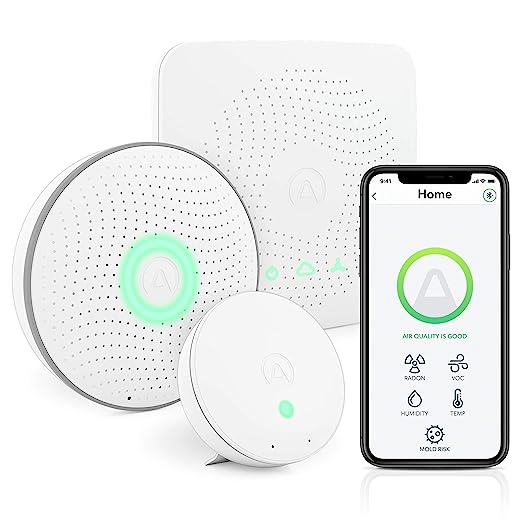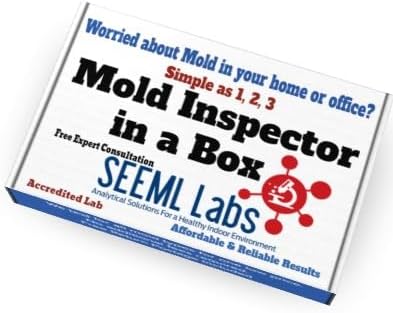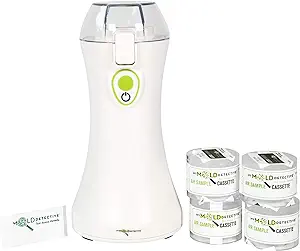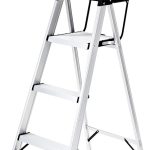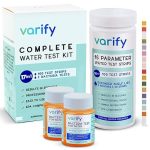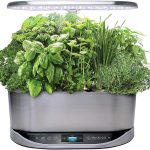As the old adage goes, “an ounce of prevention is worth a pound of cure.” When it comes to mold growth in your home, being proactive can save you from costly repairs and health issues. You’re taking the first step by considering at-home mold tests, and you’re right to do so. But with so many options available, it can be overwhelming to choose the right one. You’re about to discover the top three at-home mold tests that’ll give you the peace of mind you deserve, but first, you need to know what sets them apart – and that’s exactly what you’re about to find out.
Contents
Airthings 4200 House Kit, Indoor Air Quality Monitoring System
If you’re looking for a thorough indoor air quality monitoring system that provides multi-room coverage, the Airthings 4200 House Kit is an excellent choice, featuring a trio of devices – Wave, Wave Mini, and Hub – that work together to provide a detailed picture of your home’s air quality.
You’ll get in-depth monitoring with Wave, which detects radon levels, and Wave Mini, which tracks airborne chemicals, humidity, and temperature.
The Hub then connects everything, giving you 24/7 online access to your air quality data and alerts via the Airthings Wave app.
This system is perfect for those who want to keep a close eye on their indoor air quality, especially in multi-story homes or areas prone to radon.
Best For: Homeowners, especially those in multi-story homes or areas prone to radon, who want to monitor and improve their indoor air quality.
Pros:
- Provides multi-room coverage with three devices: Wave, Wave Mini, and Hub
- Offers accurate and detailed monitoring of radon levels, airborne chemicals, humidity, and temperature
- Allows for 24/7 online access to air quality data and alerts via the Airthings Wave app
Cons:
- Some devices may stop working after a short period of time
- Customer support can be improved to resolve issues more efficiently
- Future improvements are needed for better product functionality and accuracy
DIY Mold 3 Test Kit
When you need a reliable and convenient solution for detecting mold growth on surfaces, the DIY Mold 3 Test Kit is an excellent choice, offering a thorough testing experience with lab analysis and expert consultation included.
This kit is accredited by AIHA-LAP, LLC, and provides a thorough testing process.
You’ll collect surface samples yourself, send them to the lab, and receive a confidential report via email, along with a free consultation to help you understand the results.
With a 4.2-star rating and over 445 customer reviews, this product has proven to be a trustworthy option.
Additionally, the manufacturer, SEEML Labs, offers a product warranty and support.
Best For: Homeowners, renters, and building managers who need a reliable and convenient solution for detecting mold growth on surfaces.
Pros:
- Includes lab analysis and expert consultation for accurate and informed results
- Convenient and easy-to-use, with detailed instructions provided
- Offers a cost-effective solution with no additional lab fees necessary
Cons:
- Limited to surface testing, not suitable for air testing
- Requires users to collect samples themselves, which may not be suitable for everyone
- Add-on samples are available for an additional fee, which may increase overall cost
My Mold Detective MMD103 Mold Test Kit, 3-Room Kit
The My Mold Detective MMD103 Mold Test Kit, 3-Room Kit, stands out as a top choice for homeowners who need a thorough and convenient solution for detecting mold in multiple areas of their home.
You’ll appreciate the patented Air Sampling Pump that makes it easy to collect air samples, and the 3-step process that guides you through collecting, registering, and mailing your samples to the lab.
With this kit, you’ll get an outdoor sampling cassette, three indoor sampling cassettes, a tape strip for surface sampling, and clear instructions to help you along the way.
Plus, you’ll have access to certified IAQ Consultants for guidance and recommendations.
Best For: Homeowners who need a thorough and convenient solution for detecting mold in multiple areas of their home.
Pros:
- Easy to use and provides accurate mold test results
- Fast turnaround time for lab results (5 days)
- Detailed and easy-to-understand report
Cons:
- Additional cost for lab analysis fees ($35 per sample)
- Some customers experienced issues with the product, such as broken units and unclear instructions
- Limited warranty period (30 days)
Factors to Consider When Choosing At-Home Mold Tests
When choosing an at-home mold test, you’ll want to verify several key factors to guarantee you get accurate results.
You’ll need to ponder the test’s ability to detect mold accurately, as well as any additional features that might be important to you, such as radon detection or air quality monitoring.
Accurate Test Results
You need accurate test results to determine if your home has a mold problem, and that depends on several key factors.
When choosing an at-home mold test, you want to make certain that the results you get are reliable and trustworthy. One vital aspect is proper sampling and testing procedures.
This includes following a 3-step process of collecting air samples, registering samples, and mailing them to a lab for analysis. This guarantees that the samples are handled correctly, and the results are accurate.
Another key factor is lab analysis. Some products, like the DIY Mold 3 Test Kit, include lab analysis and expert consultation to confirm accurate and actionable results.
This is particularly important when it comes to identifying high levels of Total VOCs (toxins and chemicals), which can affect health, especially for people with allergies or respiratory issues.
Radon Detection Importance
Radon’s silent but deadly presence in your home demands continuous monitoring, especially in the lowest levels where you spend most of your time.
As the leading cause of lung cancer after smoking, radon poses a significant threat to your health. You shouldn’t take it lightly.
When you close your windows and turn on your heating systems, radon levels can increase, making it essential to monitor radon levels regularly.
Short-term measurements mightn’t give you an accurate picture of your exposure risk, so ongoing monitoring is vital.
With devices like Airthings, you can get accurate radon level readings, empowering you to take proactive measures to reduce your exposure risk.
Radon is a silent killer, and only through ongoing monitoring can you establish a safe indoor environment.
Don’t wait until it’s too late; prioritize radon detection and monitoring to safeguard your health.
Air Quality Monitoring
As you take proactive steps to mitigate radon risks, don’t overlook another critical aspect of indoor air quality: mold growth, which can exacerbate respiratory issues and trigger allergic reactions.
You’re likely aware that mold thrives in damp environments, making it essential to monitor humidity levels and identify potential moisture sources.
When choosing an at-home mold test, consider one that integrates air quality monitoring features. This might include sensors that detect temperature, humidity, and particulate matter (PM) levels. Some tests may also track volatile organic compounds (VOCs), which can contribute to poor indoor air quality.
By monitoring these factors, you’ll gain a better understanding of your home’s air quality and identify potential mold growth hotspots.
Look for tests that provide real-time data and alerts, enabling you to take prompt action against mold growth.
Product Limitations Awareness
When selecting an at-home mold test, be aware of the potential limitations and pitfalls associated with these products, which can impact their accuracy and effectiveness in identifying mold growth.
For instance, some kits, like the DIY Mold 3 Test Kit, only test for surface mold and aren’t suitable for air testing. You may also encounter additional fees, such as the $35 lab analysis fee for each sample with the My Mold Detective MMD103 Mold Test Kit.
Furthermore, you should be prepared for potential product malfunctions and inaccurate readings, as experienced by some customers with the Airthings 4200 House Kit.
Limited warranty periods, like the 30-day warranty against manufacturer defects for the My Mold Detective MMD103 Mold Test Kit, can also be a concern.
Additionally, some devices may have issues with functionality and accuracy, as seen in some reviews of the Airthings 4200 House Kit.
Being aware of these limitations will help you make an informed decision when choosing an at-home mold test that meets your needs.
Easy Setup Process
An at-home mold test with a straightforward setup process is essential, as it significantly contributes to the overall user experience and accuracy of the results.
A smooth setup process facilitates your ability to focus on collecting accurate samples rather than getting bogged down in complicated instructions.
Look for tests that provide pre-labeled sampling cassettes, like some DIY mold test kits, which minimize errors and make the process more manageable.
Some devices, such as Airthings, offer easy setup and pairing with your iPhone and network router, making it convenient to start monitoring indoor air quality.
Others may provide a simple 3-step process, involving collecting air samples, registering samples, and mailing them to a lab.
By choosing an at-home mold test with a hassle-free setup process, you’ll be more likely to follow through with the test and obtain accurate results.
This, in turn, will lead to a better understanding of your indoor air quality and the necessary steps to improve it.
Lab Analysis Inclusion
Five key factors come into play when considering lab analysis inclusion in an at-home mold test kit.
The cost of analysis is one crucial factor, as you’ll want to think about whether the kit you’re considering includes lab analysis in the initial purchase price or if it’s an additional fee. For example, the My Mold Detective MMD103 kit charges $35 per sample for lab analysis.
Another important consideration is the turnaround time. You should think about how long you’re willing to wait for your results. Some kits, like the My Mold Detective MMD103, promise fast turnaround times of around 5 days, while others may take longer.
The level of detail provided in the report is also a vital factor. You should think about whether a simple ‘yes’ or ‘no’ to mold detection will suffice, or if you need a more detailed breakdown of the types and quantities of mold present.
Surface Sampling Method
Typically, at-home mold test kits that employ surface sampling methods, such as the DIY Mold 3 Test Kit, involve collecting samples from surfaces to identify mold growth in specific areas.
You’ll collect samples using tape lifts, swab samples, or bulk samples, which will help you pinpoint exactly where mold is growing.
This targeted approach allows you to focus your cleaning and remediation efforts on the areas that need it most.
Surface sampling can be especially useful when you’ve already spotted visible signs of mold, but it may not detect growth in areas with no visible signs.
Keep in mind that surface sampling is often used in conjunction with air sampling to get a thorough picture of mold contamination in your space.
Certified Consultant Guidance
When choosing an at-home mold test kit, one key factor to keep in mind is access to certified consultant guidance, which can provide valuable support in interpreting test results and developing a plan to address mold growth.
Having access to certified consultant guidance can provide reassurance and clarity when interpreting mold test results and determining the best course of action for remediation.
Some at-home mold test kits, like the My Mold Detective MMD103, offer access to certified IAQ consultants for guidance and recommendations, providing an added layer of support for users.
These certified consultants can provide personalized advice and recommendations based on the specific results of the mold test, helping you understand the severity of the mold issue and how to address it.
They can also help you identify potential sources of mold growth and provide strategies for preventing future mold issues.
This guidance is especially important if you have a compromised immune system or respiratory issues, as you may be more susceptible to the health effects of mold exposure.
Frequently Asked Questions
Can I Use At-Home Mold Tests for Black Mold Detection?
You’re wondering if at-home mold tests can detect black mold? Yes, you can use them for that! These tests usually involve sampling the air or surfaces, and then sending the samples to a lab for analysis.
How Long Does It Take to Get Results From a Mold Test?
‘You thought getting mold test results would be a challenging task, but surprisingly, it’s a breeze! You’ll typically get your answers within 1-5 business days, depending on the type of test and lab processing time.’
Are At-Home Mold Tests as Accurate as Professional Testing?
You’re wondering if at-home mold tests are as accurate as professional testing. Honestly, they’re not; while convenient, DIY tests can produce false negatives or positives, whereas pros use specialized equipment for more precise results.
Can I Use an At-Home Mold Test to Detect Mold in HVAC Systems?
As you venture into the uncharted territory of your HVAC system, beware: at-home mold tests may not be the treasure map you need to uncover hidden mold growth, and professional guidance is often the wisest choice.
Do At-Home Mold Tests Detect Mold Spores in the Air?
You’re wondering if at-home mold tests can detect mold spores in the air. The answer is yes, many tests can detect airborne mold spores, but you must choose a test that specifically targets air sampling, like an air quality test or a spore trap.
Conclusion
You’ve taken the first step in protecting your home and health by considering at-home mold tests.
Did you know that the EPA estimates that indoor air pollution can be 2-5 times higher than outdoor levels?
By choosing the right mold test kit, you’re taking control of your indoor air quality.
Remember, it’s always better to be proactive about mold detection – your health depends on it.
